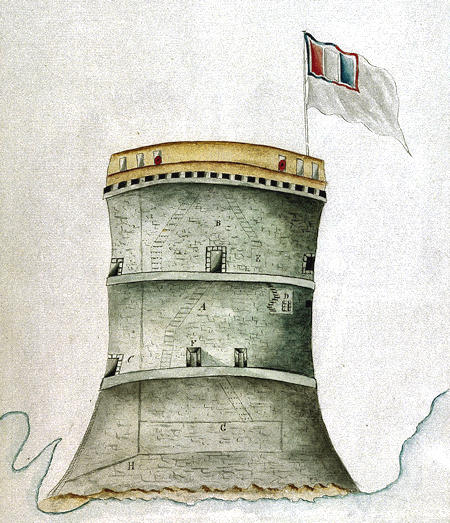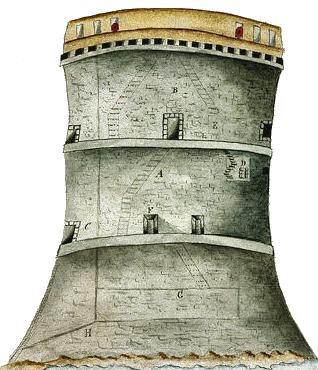About Martellos

Since the 15th century, the Corsicans had built similar towers at strategic points around the island to protect coastal villages and shipping from North African pirates. The towers stood one or two storeys high and measured 12–15 m (39–49 ft) in diameter, with a single doorway five metres off the ground that one could access only via a ladder which the occupants could remove.
Local villagers paid for the towers and watchmen, known as torregiani, who would signal the approach of unexpected ships by lighting a beacon fire on the tower's roof. The fire would alert the local defense forces to the threat. Although the pirate threat subsequently dwindled, the Genovese built a newer generation of circular towers (the Genoese towers), that warded off later foreign invasions.

Mortella Tower at San Fiorenzo Bay, Corsica 1794
On 7 February 1794 as part of the siege of Saint-Florent, two British warships, HMS Fortitude (74 guns) and HMS Juno (32 guns), unsuccessfully attacked the tower at Mortella Point; the tower eventually fell to land-based forces under Sir John Moore after two days of heavy fighting. What helped the British was that the tower's two 18-pounder guns fired seaward, while only the one 6-pounder could fire land-ward.
Vice-Admiral Lord Hood reported:
...The Fortitude and Juno were ordered against it, without making the least impression by a continued cannonade of two hours and a half;
and the former ship being very much damaged by red-hot shot, both hauled off. The walls of the Tower were of a prodigious thickness, and the parapet, where there were two eighteen-pounders, was lined with bass junk, five feet from the walls, and filled up with sand; and although it was cannonaded from the Height for two days, within 150 yards, and appeared in a very shattered state, the enemy still held out; but a
few hot shot setting fire to the bass, made them call for quarter. The number of men in the Tower was 33; only two were wounded, and those mortally.

Mortella Tower Corsica 1794
Late in the previous year, the tower's French defenders had abandoned it after HMS Lowestoffe (32 guns) had fired two broadsides at it. The British removed the guns to arm a small vessel; consequently, the French were easily able to dislodge the garrison of Corsican patriots that had replaced them. Still, the British were impressed by the effectiveness of the tower when properly supplied and defended, and copied the design.
Why are the towers known as Martello and not Mortella? There is no doubt that Martello Towers are based on the Mortella Tower at San Fiorenzo Bay in Corsica, so why the change to Martello?
There are many theories and the truth is almost certainly included within them.
Firstly, that the British simply got the name wrong, either mispronouncing or misspelling, or a combination of both, "Mortella" as "Martello"?
[There is strong support for this explanation as there is on record a letter sent by Lord Hood, Commander in Chief of the Fleet in the Mediterranean, from Victory, Martello-Bay, August 5, 1794, and included the paragraph Upon my junction with Vice- Admiral Hotham off this port, on the 9th, I detached Captain Nelson, in the Aga-
memnon, to Bastia, with orders to embark the troops, and proceed with them to Martello Bay, where Lieutenant-General Stuart embarked on the 15th; and expressing a wish to proceed to the attack of Calvi immediately, Captain Nelson complied with it, and on the 19th all the troops were landed, under the direction of Captain Cooke, in a small cove, about three miles from Calvi.]
Or was there confusion with the watchtowers in parts of Western Italy, known as 'torri di martello', as these towers used a hammer - which is martello in Italian - striking a bell to give warning?
Or was it based on 'Myrtello Point', which was the geographical name of the headland where the tower stood; the headland was covered in the wildflower Myrtle?
Whatever the truth of the matter, there were several versions of the names used until the name Martello Towers become common usage from 1803.




 Red Dragon I.T. Ltd.
Red Dragon I.T. Ltd.